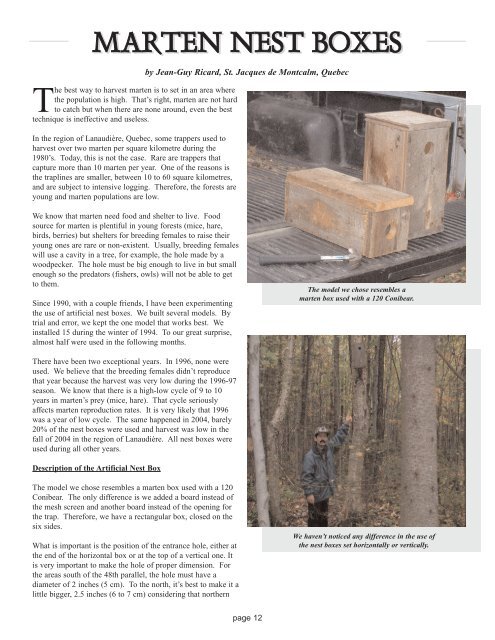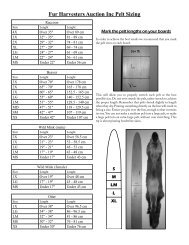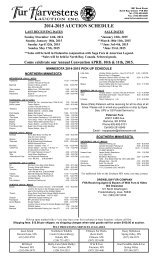Create successful ePaper yourself
Turn your PDF publications into a flip-book with our unique Google optimized e-Paper software.
<strong>MARTEN</strong> <strong>NEST</strong> <strong>BOXES</strong><br />
The best way to harvest marten is to set in an area where<br />
the population is high. That’s right, marten are not hard<br />
to catch but when there are none around, even the best<br />
technique is ineffective and useless.<br />
In the region of Lanaudière, Quebec, some trappers used to<br />
harvest over two marten per square kilometre during the<br />
1980’s. Today, this is not the case. Rare are trappers that<br />
capture more than 10 marten per year. One of the reasons is<br />
the traplines are smaller, between 10 to 60 square kilometres,<br />
and are subject to intensive logging. Therefore, the forests are<br />
young and marten populations are low.<br />
We know that marten need food and shelter to live. Food<br />
source for marten is plentiful in young forests (mice, hare,<br />
birds, berries) but shelters for breeding females to raise their<br />
young ones are rare or non-existent. Usually, breeding females<br />
will use a cavity in a tree, for example, the hole made by a<br />
woodpecker. The hole must be big enough to live in but small<br />
enough so the predators (fishers, owls) will not be able to get<br />
to them.<br />
Since 1990, with a couple friends, I have been experimenting<br />
the use of artificial nest boxes. We built several models. By<br />
trial and error, we kept the one model that works best. We<br />
installed 15 during the winter of 1994. To our great surprise,<br />
almost half were used in the following months.<br />
There have been two exceptional years. In 1996, none were<br />
used. We believe that the breeding females didn’t reproduce<br />
that year because the harvest was very low during the 1996-97<br />
season. We know that there is a high-low cycle of 9 to 10<br />
years in marten’s prey (mice, hare). That cycle seriously<br />
affects marten reproduction rates. It is very likely that 1996<br />
was a year of low cycle. The same happened in 2004, barely<br />
20% of the nest boxes were used and harvest was low in the<br />
fall of 2004 in the region of Lanaudière. All nest boxes were<br />
used during all other years.<br />
Description of the Artificial Nest Box<br />
The model we chose resembles a marten box used with a 120<br />
Conibear. The only difference is we added a board instead of<br />
the mesh screen and another board instead of the opening for<br />
the trap. Therefore, we have a rectangular box, closed on the<br />
six sides.<br />
What is important is the position of the entrance hole, either at<br />
the end of the horizontal box or at the top of a vertical one. It<br />
is very important to make the hole of proper dimension. For<br />
the areas south of the 48th parallel, the hole must have a<br />
diameter of 2 inches (5 cm). To the north, it’s best to make it a<br />
little bigger, 2.5 inches (6 to 7 cm) considering that northern<br />
by Jean-Guy Ricard, St. Jacques de Montcalm, Quebec<br />
page 12<br />
The model we chose resembles a<br />
marten box used with a 120 Conibear.<br />
We haven’t noticed any difference in the use of<br />
the nest boxes set horizontally or vertically.
marten are bigger. The hole must not be too big.<br />
This is to prevent the males and predators entering<br />
the box.<br />
The dimensions of the box are 6 x 6 inches, 14 to<br />
16 inches long or high. If the box is too small, the<br />
marten will not be able to set up inside. If it’s too<br />
big, the breeding female will not be able to keep<br />
her little ones warm during the cold nights in<br />
April. Make sure all the joints are watertight to<br />
prevent rain or light from getting into the box.<br />
The wood must be clean (no glue, paint,<br />
fiberglass, cement, etc) and of grayish colour (old<br />
wood left in the sun).<br />
Where to install the nest boxes?<br />
Answer: in the forest. The most efficient way to<br />
look for and find the best places for the nest boxes<br />
is to use an aerial photo or a recent forestry map.<br />
By forest, I mean: you must have a one-part<br />
surface area greater than 0.7 square kilometres.<br />
Trees along water edges or patches left by loggers<br />
do not count.<br />
The forest must also present a surface greater than 16 square<br />
metres per hectare and trees must have a height greater than<br />
9 m (30 ft). With a surface greater than 16 square metres per<br />
hectare, we have the impression of walking in the forest. Under<br />
16 square metres per hectare, it feels like you’re walking<br />
through a piece of industrial land or urban park. Visibility is<br />
greater than 200 metres.<br />
Ideally, the nest boxes should be installed at approximately 100<br />
metres from a creek with a good alder edge. Marten look for<br />
alder in the spring.<br />
Nest boxes must always be installed in deciduous trees. Avoid<br />
coniferous because they produce resin that damages the<br />
marten’s fur. My preferred choices are yellow birch and white<br />
birch and it’s best if you can set up the box on the south side of<br />
the tree. The sun will help keep the tenants warm.<br />
They must be installed at a height greater than 3 metres,<br />
measured from the top of the snow. If there’s one metre of<br />
snow on the ground, the box will be set at 4 metres. The<br />
horizontal boxes are easy to install in the fork of a tree and it’s<br />
easy to install the vertical ones directly to the trunk of a tree.<br />
Finally, it’s important to leave one kilometre between the nest<br />
boxes. It reduces the competition between the females.<br />
Trapping<br />
The principle is for the trapper to harvest the young born in the<br />
nest boxes and avoid the females. For that reason, it is very<br />
important not to set any traps within a radius of 0.5 km from the<br />
nest boxes. That is the breeding female’s territory. As they are<br />
territorial and have a life expectancy of more than 15 years, we<br />
are expecting that the production of each nest box will be<br />
This is an example of a forestry map. Scale 1:20,000<br />
Location of 6 marten nest boxes<br />
X: Nest boxes<br />
++++: Breeding female territory (do not set traps)<br />
Waterway<br />
----- Road<br />
preserved and steady in the future. In the fall, we have captured<br />
between two and three juvenile marten per nest box.<br />
Tips<br />
page 13<br />
In March, when you have a hard snow crust, it’s easy to go<br />
around on your skidoo and put up your nest boxes. Then it is<br />
very important not to disturb the breeding females between the<br />
end of March and the end of June.<br />
Early August, it’s exciting to go see if the nest boxes have been<br />
used. On some of the boxes, we’ve even added a little door at<br />
the back to check if there have been any tenants. If this is the<br />
case, there should be a lot of marten hair mixed with grass,<br />
leaves and wood chips. The nest boxes are always clean. Don’t<br />
worry if the birds or squirrels are using the nest boxes. The<br />
female marten will fix that problem.<br />
Finally, it is suggested to feed the female marten at the end of<br />
the winter; for example, with beaver carcasses placed in their<br />
territory. These carcasses should be disposed of at<br />
approximately 0.3 km from the nest boxes to avoid predators<br />
from finding the female marten.<br />
Addendum<br />
I stored a nest box under my trap camp for several years. My<br />
camp is built on piles approximately four feet high. I use that<br />
space for storage. Believe it or not, a female marten used the<br />
nest box for two years. For fun, I placed a beaver carcass on a<br />
stump about 20 feet in front of the camp. Practically each<br />
morning for two seasons, the marten would come out from<br />
under the camp and snack on the beaver carcass. Just imagine<br />
having coffee in the morning watching a marten in action just a<br />
few feet away! For some unknown reason, she disappeared.<br />
The added bonus - there were no mice to be found around the<br />
camp.






